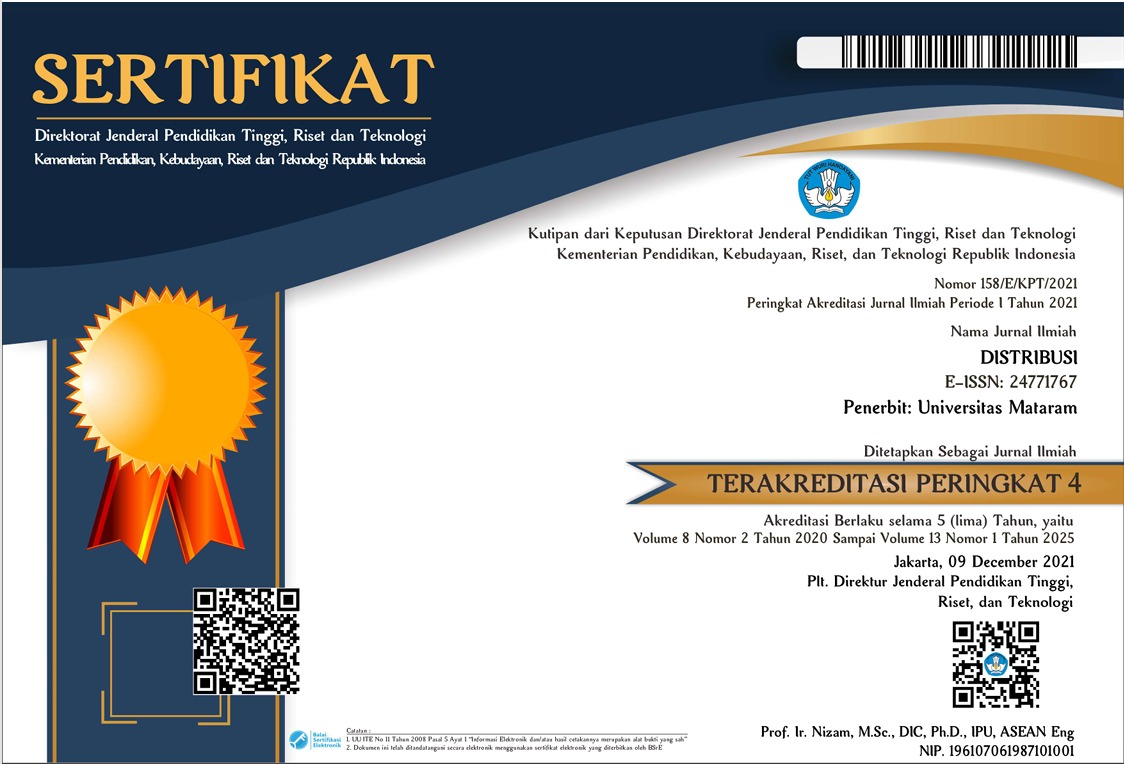ANALISIS STRATEGI INOVASI TERHADAP KINERJA PERUSAHAAN E-COMMERCE YANG DIMODERASI LEADERSHIP
DOI:
https://doi.org/10.29303/distribusi.v11i2.381Keywords:
e-commerce, kepemimpinan, kinerja perusahaan, strategi inovasiAbstract
Strategi inovasi sangat melekat dengan perusahaan e-commerce yang selalu senantiasa membutuhkan inovasi-inovasi dengan pengetahuan dan teknologi informasi yang tinggi dan kepemimpinan yang memiliki inovasi-inovasi sehingga menghasilkan kinerja perusahaan yang bagus. Tujuan penelitian ini adalah menguji pengaruh strategi inovasi terhadap kinerja perusahaan yang dimediasi oleh leadership. Jenis penelitian yang digunakan adalah penelitian asosiatif dengan pendekatan kuantitatif. Teknik pengambilan sampel menggunakan metode purposive sampling. Sampel dalam penelitian ini adalah perusahaan e-commerce terdaftar di Bursa Efek Indonesia (BEI) dengan total sample sebanyak 15 perusahaan dan jumlah observasinya sebanyak 75 observan. Untuk menguji hipotesis digunakan analisis regresi berganda dengan menggunakan aplikasi stata 14.2. Penelitian dapat disimpulkan antara lain bahwa nilai strategi inovasi perusahaan tidak berpengaruh terhadap kinerja perusahaan baik kinerja akuntansi maupun kinerja pasar dan leadership tidak mampu memoderasi/memperkuat hubungan antara nilai strategi inovasi dengan kinerja perusahaan.
Downloads
References
Abdillah, W., & Jogiyanto. (2015). Partial Least Square (PLS), Alternative Structural Equation Model (SEM) Dalam Penelitian Bisnis. Yogyakarta : Andi.
AlAnazi, A. A., Kura, K. M., Suleiman, E. S., & Abubakar, R. A. (2021). Mediating effect of organisational innovation in the prediction of change-oriented leadership on organisational performance. International Journal of Innovation Science. https://doi.org/10.1108/IJIS-03-2021-0051
Anzola-Román, P., Bayona-Sáez, C., & García-Marco, T. (2018). Organizational innovation, internal R&D and externally sourced innovation practices: Effects on technological innovation outcomes. Journal of Business Research, 91(August 2017), 233–247. https://doi.org/10.1016/j.jbusres.2018.06.014
Azar, G., & Drogendijk, R. (2014). Psychic Distance, Innovation, and Firm Performance. Management International Review, 54(5), 581–613. https://doi.org/10.1007/s11575-014-0219-2
Battisti, G., & Stoneman, P. (2010). How innovative are UK firms? Evidence from the fourth UK community innovation survey on synergies between technological and organizational innovations. British Journal of Management, 21(1), 187–206. https://doi.org/10.1111/j.1467-8551.2009.00629.x
Chen, J., & Liu, L. (2018). Profiting from Green innovation: The moderating effect of competitive strategy. Sustainability (Switzerland), 11(1). https://doi.org/10.3390/su11010015
Damanpour, F., Walker, R. M., & Avellaneda, C. N. (2009). Combinative effects of innovation types and organizational Performance: A longitudinal study of service organizations. Journal of Management Studies, 46(4), 650–675. https://doi.org/10.1111/j.1467-6486.2008.00814.x
Evangelista, R., & Vezzani, A. (2010). The economic impact of technological and organizational innovations. A firm-level analysis. Research Policy, 39(10), 1253–1263. https://doi.org/10.1016/j.respol.2010.08.004
Fatema, F., & Islam, M. M. (2021). Do innovations improve firm performance in the Indian manufacturing sector? A mediation and synergy effect analysis. International Journal of Emerging Markets. https://doi.org/10.1108/IJOEM-05-2020-0495
Ghozali, I. (2011). Structural Equation Modeling Metode Alternatif dengan Partial Least Square (PLS) (3rd ed.). Semarang : Undip.
González-Cruz, T. F., Roig-Tierno, N., & Botella-Carrubí, D. (2018). Quality management as a driver of innovation in the service industry. Service Business, 12(3), 505–524. https://doi.org/10.1007/s11628-017-0360-7
Hobday, M., Rush, H., & Bessant, J. (2004). Approaching the innovation frontier in Korea: The transition phase to leadership. Research Policy, 33(10), 1433–1457. https://doi.org/10.1016/j.respol.2004.05.005
Hung, K. P., & Chou, C. (2013). The impact of open innovation on firm performance: The moderating effects of internal R&D and environmental turbulence. Technovation, 33(10–11), 368–380. https://doi.org/10.1016/j.technovation.2013.06.006
Jia, X., Chen, J., Mei, L., & Wu, Q. (2018). How leadership matters in organizational innovation: a perspective of openness. Management Decision, 56(1), 6–25. https://doi.org/10.1108/MD-04-2017-0415
Lee, R., Lee, J. H., & Garrett, T. C. (2019). Synergy effects of innovation on firm performance. Journal of Business Research, 99(August), 507–515. https://doi.org/10.1016/j.jbusres.2017.08.032
Leite, E. (2022). Innovation networks for social impact: An empirical study on multi-actor collaboration in projects for smart cities. Journal of Business Research, 139(September 2021), 325–337. https://doi.org/10.1016/j.jbusres.2021.09.072
Liao, S., Fu, L., & Liu, Z. (2020). Investigating open innovation strategies and firm performance: the moderating role of technological capability and market information management capability. Journal of Business and Industrial Marketing, 35(1), 23–39. https://doi.org/10.1108/JBIM-01-2018-0051
Miller, L., & Miller, A. F. (2020). Innovative work behavior through high-quality leadership. International Journal of Innovation Science, 12(2), 219–236. https://doi.org/10.1108/IJIS-04-2019-0042
Moon, C., & Acquaah, M. (2020). Performance implications of combining creative and imitative innovation strategies. European Journal of Innovation Management. https://doi.org/10.1108/EJIM-06-2020-0213
Naqshbandi, M. M., & Tabche, I. (2018). The interplay of leadership, absorptive capacity, and organizational learning culture in open innovation: Testing a moderated mediation model. Technological Forecasting and Social Change, 133(February), 156–167. https://doi.org/10.1016/j.techfore.2018.03.017
O’Neill, D., De Vries, J., & Comiskey, C. M. (2021). Leadership and community healthcare reform: a study using the Competing Values Framework (CVF). Leadership in Health Services, 34(4), 485–498. https://doi.org/10.1108/LHS-01-2021-0007
Pang, C., Wang, Q., Li, Y., & Duan, G. (2019). Integrative capability, business model innovation and performance: Contingent effect of business strategy. European Journal of Innovation Management, 22(3), 541–561. https://doi.org/10.1108/EJIM-09-2018-0208
Piarna, R., Fathurohman, F., & Nugraha, N. (2020). Understanding online shopping adoption : The unified theory of acceptance and the use of technology with perceived risk in millennial consumers context. Jurnal Ilmiah Bidang Akuntansi Dan Manajemen, 17(1), 51–66. https://doi.org/10.31106/jema.v17i1.5050
Pradana, M. (2016). Klasifikasi Bisnis E-Commerce Di Indonesia. Modus, 27(2), 163. https://doi.org/10.24002/modus.v27i2.554
Pudjiarti, E. S., & Priagung Hutomo, P. T. (2020). The critical role of effective organizational learning to improve firm’s innovation and performance in a market turbulence condition. International Journal of Innovation Science, 12(3), 237–254. https://doi.org/10.1108/IJIS-08-2019-0079
Rizaty, M. A. (2021). Transaksi E-Commerce Indonesia Diproyeksikan Capai Rp 403 Triliun pada 2021. https://databoks.katadata.co.id/datapublish/2021/11/25/transaksi-e-commerce-indonesia-diproyeksikan-capai-rp-403-triliun-pada-2021
Sears, J., & Hoetker, G. (2014). Technological overlap, technological capabilities, and resource recombination in technological acquisitions. Strategic Management Journal, 35(1), 48–67. https://doi.org/10.1002/smj.2083
Solís-Molina, M., Hernández-Espallardo, M., & Rodríguez-Orejuela, A. (2021). Co-exploitation (or co-exploration) vs go it alone? The role of alliance learning capability on firm performance. Journal of Business and Industrial Marketing, November 2020. https://doi.org/10.1108/JBIM-11-2020-0526
Sölvell, I. (2018). Managers’ silent whisper innovation involvement and role-modeling in service firms. European Journal of Innovation Management, 21(1), 2–19. https://doi.org/10.1108/EJIM-02-2017-0020
Sugiyono. (2011). Metode Penelitian Kuantitatif Kualitatif dan R&D. Bandung : Alfabeta.
Sugiyono, P. D. (2018). Penelitian Kuantitatif, Kualitatif, dan R&D. Alfabeta.
Tavassoli, S., & Karlsson, C. (2016). Innovation strategies and firm performance: Simple or complex strategies? Economics of Innovation and New Technology, 25(7), 631–650. https://doi.org/10.1080/10438599.2015.1108109
Torres, P., & Augusto, M. (2020). Understanding complementarities among different forms of innovation. European Journal of Innovation Management, 23(5), 813–834. https://doi.org/10.1108/EJIM-01-2019-0012
Turner, M. J., Way, S. A., Hodari, D., & Witteman, W. (2017). Hotel property performance: The role of strategic management accounting. International Journal of Hospitality Management, 63, 33–43. https://doi.org/10.1016/j.ijhm.2017.02.001
Vaid, S., & Honig, B. (2020). The influence of investors’ opinions of human capital and multitasking on firm performance: a knowledge management perspective. Journal of Knowledge Management, 24(7), 1585–1603. https://doi.org/10.1108/JKM-01-2020-0075
Venkatesh, V., Thong, J. Y. L., & Xin, X. (2012). Consumer Acceptance and Use of Information Technology: Extending the Unified Theory of Acceptance and Use of Technology. MIS Quarterly, 36(1), 157–178. https://doi.org/10.1109/MWSYM.2015.7167037
Wang, C., Chin, T., & Lin, J. H. (2020). Openness and firm innovation performance: the moderating effect of ambidextrous knowledge search strategy. Journal of Knowledge Management, 24(2), 301–323. https://doi.org/10.1108/JKM-04-2019-0198
Zhang, H., Xiao, H., Wang, Y., Shareef, M. A., Akram, M. S., & Goraya, M. A. S. (2021). An integration of antecedents and outcomes of business model innovation: A meta-analytic review. Journal of Business Research, 131(October), 803–814. https://doi.org/10.1016/j.jbusres.2020.10.045
Ziadlou, D. (2021). Strategies during digital transformation to make progress in achievement of sustainable development by 2030. Leadership in Health Services, 34(4), 375–391. https://doi.org/10.1108/LHS-08-2020-0056
Downloads
Published
How to Cite
Issue
Section
License
Copyright (c) 2023 Nurabiah, Herlina Pusparini, Nur Fitriyah

This work is licensed under a Creative Commons Attribution-ShareAlike 4.0 International License.
Penulis yang naskahnya diterbitkan menyetujui ketentuan sebagai berikut:
- Hak publikasi atas semua materi naskah jurnal yang diterbitkan/dipublikasikan dalam situs Jurnal DISTRIBUSI ini dipegang oleh dewan redaksi dengan sepengetahuan penulis (hak moral tetap milik penulis naskah).
- Ketentuan legal formal untuk akses artikel digital jurnal elektronik ini tunduk pada ketentuan lisensi Creative Commons Attribution-ShareAlike (CC BY-SA), yang berarti Jurnal DISTRIBUSI berhak menyimpan, mengalih media/format-kan, mengelola dalam bentuk pangkalan data (database), merawat, dan mempublikasikan artikel tanpa meminta izin dari Penulis selama tetap mencantumkan nama Penulis sebagai pemilik Hak Cipta.
- Naskah yang diterbitkan/dipublikasikan secara cetak dan elektronik bersifat open access untuk tujuan pendidikan, penelitian, dan perpustakaan. Selain tujuan tersebut, dewan redaksi tidak bertanggung jawab atas pelanggaran terhadap hukum hak cipta.









